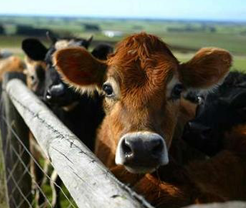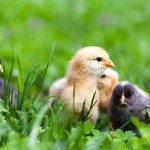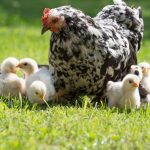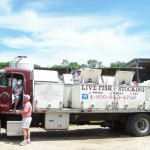 Now is the perfect time for beef producers to make management decisions that will affect the health, productivity and profitability of the herd over the next production cycle. The following are tips and guidelines to consider.
Now is the perfect time for beef producers to make management decisions that will affect the health, productivity and profitability of the herd over the next production cycle. The following are tips and guidelines to consider.
1. Wean based on pasture quality and quantity:
When pasture quality declines below that required to support calf growth, and/or quantity declines to the point that calves cannot compete with cows for the available forage, calves will start to loose body weight. It is a myth that calf growth will be maintained by milk production; by the time calves reach 400 pounds, and especially when forage availability is low, milk intake will supply as little as ten percent of the calfs nutritional requirements, and some cows will voluntarily dry off. When this occurs it is more beneficial and economical to wean the calves as it:
a. Is easier and more economical to supplement the calves than the whole herd,
b. will extend the grazing for the cow herd, and
c. will reduce the extent of body weight loss in the cow herd, especially for first calf heifers.
“A research project at Kansas State University a few years ago showed that cows on unsupplemented pasture who continued nursing calves until December lost about 150 pounds and 1.5 points in body condition score by their next calving. If calves must be left on the cows this late, pasture must be supplemented.” (Heather Smith Thomas, cattletoday.com, Oct. 29, 2002)
2. Preg–check cows and heifers:
At weaning, preg–check all animals that were bred, and cull those that are open or will calve late. Open cows are too expensive to maintain on limited and costly feed resources these days, as can be cows that will calve outside a 70 to 90 day calving window. Late calvers will generally wean small calves the following year and be even harder to breed back in time to calve within the target window.
This is also a good time to check the cows to detect and deal with problems that might affect future health or productivity, such as age, teeth condition, illness or injury.
3. Assess body condition and group cows/heifers for fall/winter feeding:
Target for a moderate body condition (4–6 on a 9 point scale) going into the colder weather of winter, as well as before calving. If possible, group thinner cows with bred heifers after weaning and place them on a higher plane of nutrition than the rest of the herd so that the higher nutritional requirements of the still growing heifers will be met, and the thin cows will have an opportunity to gain weight before the coldest part of the winter sets in and thus be in better condition for calving. Research shows that cows in good to moderate body condition can lose weight equivalent to two body condition scores without affecting calving or reproductive performance as long as their nutritional requirements are fully met from four weeks prior to calving and onward. Therefore, by grouping animals according to nutritional requirements and feeding accordingly, there is tremendous opportunity to save feed and labor.
4. Deworm and vaccinate:
Cows should be treated at weaning for internal and external parasites picked up during the summer and fall grazing seasons, as these increase feed requirements and susceptibility to disease during the winter. This is also a good time to give semi–annual vaccinations for diseases such as lepto, vibrio, IBR and BVD, the risk of which also increases as animals are congregated for winter feeding and calving. Your local veterinarian should be consulted to determine what the cows need to be treated for and which products should be the most effective in your area. Obviously, there is little reason to treat animals that are to be culled, so save the cost.
“Lice are one of the most costly and underrated parasites of cattle, accounting for millions of dollars lost each year due to reduced feed conversion, weight loss, anemia and sometimes even death. During the last cold months of winter and into early spring, lice can be a constant cause of irritation putting additional stress on cattle and draining energy reserves.” (Heather Smith Thomas, cattletoday.com, Oct. 29, 2002)
5. Have feed analyzed:
It is not possible to make progress in reducing feed costs and ensuring nutritional requirements are met without having feeds, and especially forages, analyzed for nutritional content. At a minimum, they should be analyzed for dry matter (DM), crude protein (CP), fiber (ADF) and the minerals calcium (Ca) and phosphorus (P), either by wet chemistry or NIR (Near Infrared) scan. Fiber analysis is essential for the lab to be able to estimate energy content as TDN (Total Digestible Nutrients) or Net Energy (NEm or NEg). Feed of different types, different cuttings and even from different fields should be analyzed separately. It may also be advisable to sample and analyze fall grazing materials such as stockpiled grass, crop residues, swath grazing, straws etc. if this has not been done before. Then, it will be possible to allocate specific feedstuffs according to stage of production and nutritional requirements over the winter feeding period.
6. Develop feeding plan/programs:
There is a tendency for beef cow–calf producers to over–feed cows between weaning and calving, and then underfeed them from late gestation through calving and rebreeding. This is very wasteful and costly. Post–weaning, cows have their lowest nutritional requirements and will do well on a diet of 48–50% TDN and a minimum of 7% CP. During the last month of gestation, calving and rebreeding, they require a diet with 60–62% TDN and a minimum of 10% CP to be healthy and productive. This is a substantial difference in feed quality that requires planning to determine how it is to be achieved with the resources at hand, and to prevent over–feeding and fattening of the cows during the “dry” period. If higher quality feeds than required are available, they can be limit fed to save feed and cost, or diluted with lower quality purchased feeds if economical sources are available. Your local feed supplier or government extension agent may be available to assist you in developing appropriate diets for each stage of production. Waiting to “see what happens” is almost always more expensive, and hard on the cattle.
7. Evaluate feed inventory:
The fall is the best time to evaluate your feed inventory and its adequacy for the coming feeding season. Once the analysis has been done, and your feeding plan has been developed, consider the length of feeding period(s) and the weather conditions being forecast, and then total up the amount of each class of feed you will require to make it through the feeding season and compare it against the inventory on hand. Be sure to include a 10–15% margin for error and an appropriate value for spoilage in storage and wastage during feeding (these latter two may be greater than you think). If the current feed inventory is not adequate to comfortably make it through the full calving season, NOW (i.e. the fall) is the best time to make adjustments, by either limiting early season feeding rates, making arrangements to buy more feed (greatest availability and lowest cost) or decreasing the size of the herd.
8. Adjust feeding rates for cold weather:
Beef cattle feed (energy) requirements increase by roughly two percent (2%) for every degree Celsius that effective temperature (measured as wind chill) drops below their lower critical temperature (about 0°C or 32°F with a normal winter coat), when they must start to actively generate heat to maintain core body temperature. If feed intake does not increase sufficiently to compensate for the drop in temperature, energy supplements will need to be provided to prevent loss in body weight and condition. Care must be taken when feeding poor quality forages, and especially straw, as the drive for intake, along with poor digestion, can cause rumen impaction during cold weather.
9. Check waterers and feeding areas:
Dry matter intake is dependent on water intake, and both are especially important during fall grazing and winter feeding when poorer quality roughage is fed. The fall is a great time to ensure all water sources are operating, clean and will remain free of ice when cold weather arrives.
It is also a great time to check and set up the winter feeding area (e.g. fencing and feeders) and feeding equipment to ensure that everything is ready when winter feeding needs to begin. This includes ensuring your TMR mixer receives its annual service, including changing the oil in the planetary gearbox, removing and cleaning under the auger of vertical mixers to check for wear and that oil lubrication parts are in good repair, checking and rotating or changing blades as required, and ensuring that the weigh bars and scale are working correctly.
10. Reduce feed wastage:
One of the easiest ways to increase cow–calf profitability is to decrease feed wastage. Feeding on the ground has been shown to waste up to 60% of feeding value through selection and trampling. Hay and bale feeders will reduce wastage but it can still reach up to 30% in traditional feeders, and increases as forage quality declines. Research at the University of Michigan showed that wastage varied by feeder type, being 3.4, 6.1 11.4 and 14.6% for cone, ring, trailer and cradle feeders when fed relatively good quality (35% ADF) mixed alfalfa–orchardgrass round bales.
Bale feeding still presents a challenge on how to feed forages, supplements and opportunity feeds in a way that each animal gets what they require; over consumption by older and more aggressive cows is also a form of wastage. For this reason many producers are experiencing the benefits of using a vertical auger, TMR mixer for feeding. With a vertical mixer, hay can be processed into a ration that minimizes sorting and virtually eliminates waste. Intake of poorer quality forages can also increase by as much as 30% helping meet requirements on lower cost feeds. Finally, it is then easy to weigh the feed and mix in grain, supplements and mineral and vitamins, as required, to balance the ration for a given stage of production, and to minimize feed cost while optimizing animal health and performance. Conservative estimates have shown that the value of a TMR mixer should be a minimum of the combination of 10 to 15% in annual feed cost, through feed savings, plus 10–15 % of the value of the animals marketed annually, through improved animal performance.
Source: Dr. Alan S. Vaage, Ruminant Nutritionist, Jaylor Fabricating



